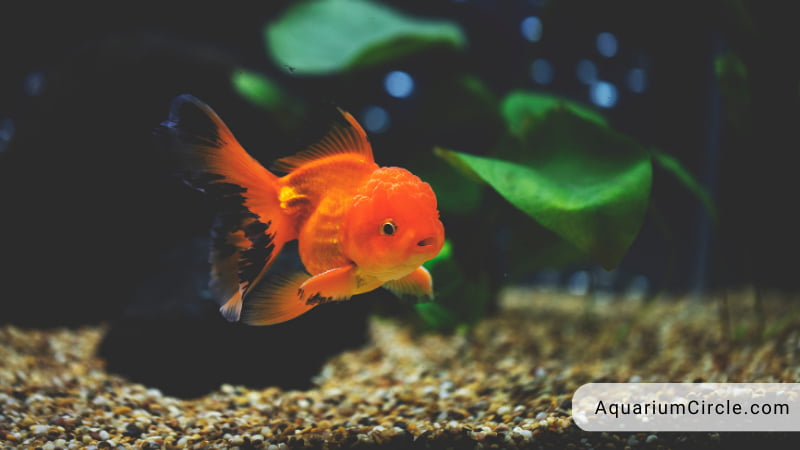Oranda Goldfish, with their distinctive appearance and playful personalities, have become a favorite among fish enthusiasts around the world. Originally from China, Oranda Goldfish were bred for their unique “wen,” a fleshy growth on their head that resembles a hood, people also call these fancy Goldfish by Goldfish with big head. Today, there are many varieties of Oranda Goldfish available in a range of colors and patterns. These stunning fish require specific care to thrive, including a suitable tank environment, a balanced diet, and proper maintenance.
In this blog post, we’ll dive into everything you need to know about this Goldfish with big head, from their physical characteristics and habitat requirements to their breeding habits and common health issues. Whether you’re a seasoned fish keeper or a beginner looking to add a new aquatic friend to your home, this guide will provide you with all the information you need to care for and enjoy these fascinating fish.
See also:
- Fantail Goldfish: Care Guide, Lifespan, Tank Size, Tank Mates In Aquarium And More
- Black Moor Goldfish: Care Guide, Breeding, Lifespan,tank Size, Tank Mates And More
- Pink Oranda Goldfish: Top 7 Information That You Need To Know When Raising This Fish
Brief Explanation Of What Oranda Goldfish Are
Oranda Goldfish are a variety of Goldfish that are popular among fish enthusiasts for their distinctive appearance and playful personalities. These fish are known for their “wen or crown,” a fleshy growth on top of the head that resembles a hood. The wen is particularly prominent in adult Oranda Goldfish, and can grow to cover the entire head of the fish. Oranda Goldfish are also known for their round, egg-shaped body and long, flowing fins. These fish are available in a range of colors and patterns, including red, black, white, blue, and calico. Originally from China, Oranda Goldfish have been bred for their unique characteristics for centuries and are now found in aquariums all over the world.
History of Oranda Goldfish and their origins
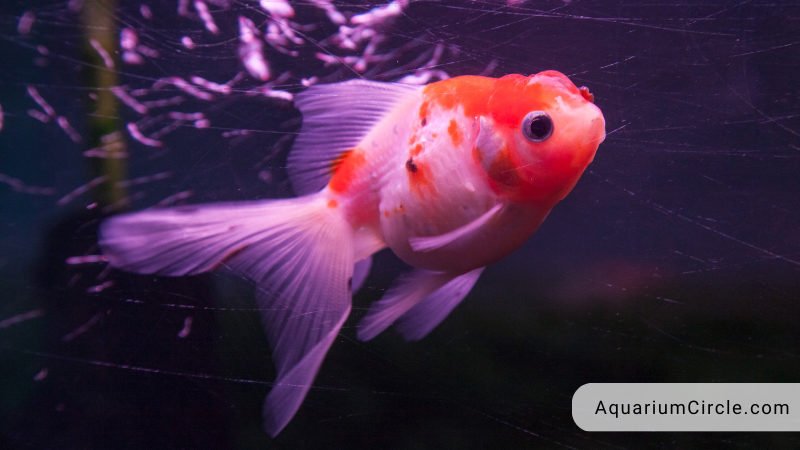
Oranda Goldfish have a long and fascinating history that dates back to the Tang dynasty in China, which began in the 7th century. The exact origin of Oranda Goldfish is unclear, but it is believed that they were first bred in China from the common Goldfish. Oranda Goldfish were developed for their distinctive appearance, which included a hood-like growth on their head.
In the late 16th century, Oranda Goldfish were introduced to Japan, where they became very popular among fish enthusiasts. Japanese breeders continued to refine the characteristics of Oranda fish, developing new color patterns and enhancing the size and shape of the wen.
In the early 20th century, Oranda Goldfish were introduced to Europe and North America, where they quickly gained popularity among fish enthusiasts. Today, Oranda Goldfish are one of the most popular varieties of Goldfish in the world and can be found in aquariums and water gardens around the globe. While Oranda Goldfish are now bred in many countries, they still have a rich history and deep cultural significance in China and Japan.
Why Oranda Goldfish are popular among fish enthusiasts?
Oranda Goldfish are popular among fish enthusiasts for several reasons:
- Unique Appearance: Oranda Goldfish are known for their distinctive hood-like growth on their head, which makes them stand out from other Goldfish varieties. Additionally, their round, egg-shaped body and flowing fins make them a visually appealing addition to any aquarium or water garden.
- Playful Personality: Oranda Goldfish are known for their playful and active personalities. They are social creatures and enjoy interacting with other fish in the tank, as well as their human caretakers.
- Easy to Care For: Oranda Goldfish are relatively easy to care for, making them a popular choice for both experienced and beginner fish keepers. They have a hardy constitution and can tolerate a wide range of water conditions, as long as their basic needs are met.
- Versatile: Oranda Goldfish can be kept in a variety of settings, including indoor aquariums and outdoor ponds or water gardens. They are also compatible with many other fish species, making them a great addition to a community tank.
- Historical and Cultural Significance: Oranda Goldfish have a rich history and cultural significance in China and Japan, where they originated. As a result, they are highly prized by fish enthusiasts who appreciate their historical and cultural value.
Overall, Oranda Goldfish are popular among fish enthusiasts because they are visually appealing, playful, easy to care for, versatile, and have cultural significance.
Description Of The Oranda Goldfish’s Body Shape And Size
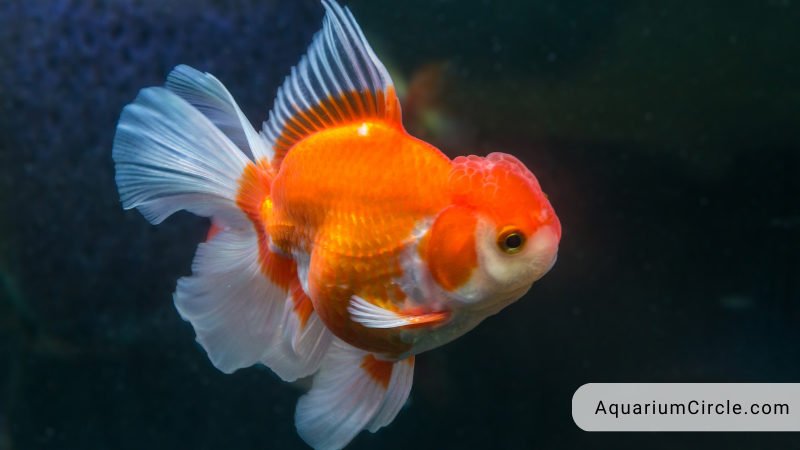
So we have just learned about the history as well as why the golfish oranda is so loved, now we will give you more information about its appearance, body shape and size to be more specific.
Oranda Goldfish have a round, egg-shaped body with a slightly curved profile. They have a dorsal fin on their back and two pairs of ventral fins on their abdomen. Their fins are long and flowing, giving them a graceful and elegant appearance in the water. Oranda Goldfish also have a unique hood-like growth on their head, known as the wen, which can vary in size and shape depending on the individual fish.
In terms of size, Oranda Goldfish can grow to be quite large. On average, they reach a length of 8 to 12 inches in length (20 to 30 cm) when fully grown, although some individuals can grow to be even larger. It is important to note that the size of an Oranda Goldfish will depend on a variety of factors, including genetics, diet, and environmental conditions. Providing a suitable tank environment, proper nutrition, and good water quality can help ensure that your Oranda Goldfish grows to be healthy and strong.
What is the “wen,” or fleshy growth on their head?
One of the defining features of Oranda Goldfish is the fleshy growth on their head, known as the wen. The wen is a type of head growth that consists of a thick layer of fleshy tissue that covers the head of the fish, extending over the eyes and down towards the mouth. The size and shape of the wen can vary significantly among individual Oranda Goldfish, and can be influenced by genetics, diet, and environmental factors.
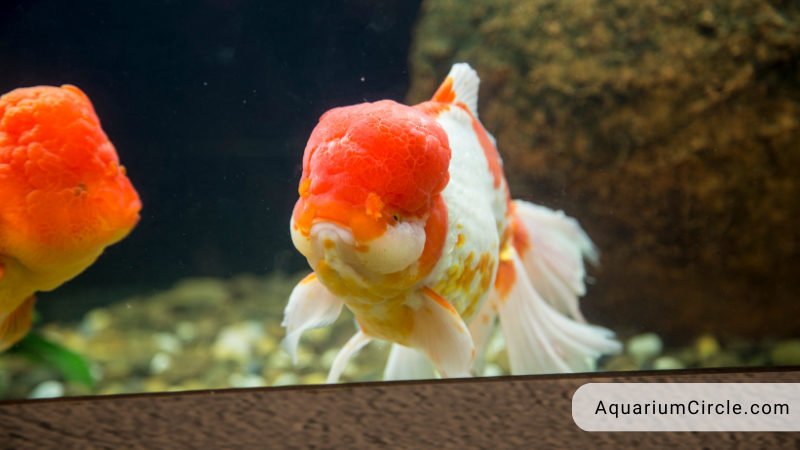
The purpose of the wen is not entirely clear, although it is believed to have both a functional and an aesthetic role. The wen is thought to help protect the eyes of the fish from injury by cushioning them against bumps and knocks. Additionally, the wen may play a role as a red cap on its head, it’s very important in attracting potential mates during Goldfish breeding season. From an aesthetic standpoint, the wen is considered to be one of the most important characteristics of an Oranda Goldfish, and is often used as a basis for judging the quality of the fish in competitions.
It is important to note that the wen can be a source of health problems for Oranda Goldfish if it becomes infected or damaged. The fleshy tissue of the wen can be prone to bacterial infections, which can lead to health issues such as inflammation, ulceration, and loss of tissue. Careful attention to water quality and regular health checks can help prevent and treat these issues. Additionally, it is important to choose a tank or pond that provides ample space for the fish to move around and avoid injuring its head growth.
Color Patterns Available In Oranda Goldfish
Oranda Goldfish are known for their stunning coloration and patterning, which can vary widely depending on the individual fish. Here are some of the most common color patterns you may encounter when selecting an Oranda Goldfish:
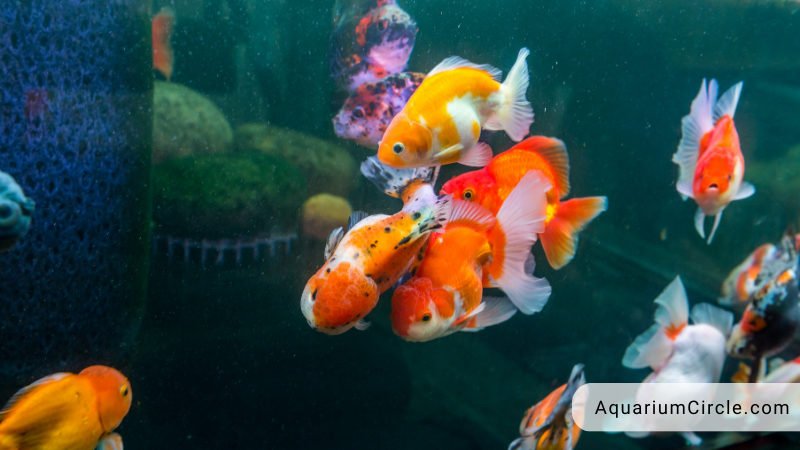
- Red and White: This is one of the most popular color patterns for Oranda Goldfish. These fish typically have a bright red body with white accents on their fins and head.
- Calico: Calico Oranda Goldfish have a combination of red, black, and white coloring on their body and fins. The pattern can be quite intricate and unique to each individual fish.
- Black: Black Oranda Goldfish have a deep, solid black coloration that can be striking in contrast to other fish in an aquarium.
- Blue: Blue Oranda Goldfish have a cool, silvery-blue coloration that can range from light to dark shades.
- Chocolate: Chocolate Oranda Goldfish have a rich brown coloration that can vary in intensity and depth.
- Panda: Panda Oranda Goldfish have a distinctive black and white coloration, with black on the top half of their body and white on the bottom.
- Tri-color: Tri-color Oranda Goldfish have three distinct colors on their body, often consisting of red, black, and white.
- Lemonhead: Lemonhead Oranda Goldfish have a bright yellow or orange coloring on their head, which can be quite striking against a contrasting body color.
These are just a few examples of the many color patterns that can be found in Oranda Goldfish. When selecting a fish, consider the colors and patterns that appeal to you, and keep in mind that these patterns can change and evolve as the fish grows and matures.
Oranda Goldfish Care Guide: Ideal Water Conditions
Providing the ideal water conditions for your Oranda Goldfish is essential for their health and well-being. Here are some key factors to consider when setting up and maintaining the water conditions in their tank or pond:
- Temperature: Oranda Goldfish prefer cold water than other Goldfish and thrive in water temperatures between 65 and 72 degrees Fahrenheit (18-22 degrees Celsius). It is important to maintain a consistent temperature in the tank or pond, as sudden fluctuations can be stressful for the fish and make them more susceptible to disease.
- pH Level: The ideal pH range for Oranda Goldfish is between 7.0 and 7.4. It is important to monitor the pH level regularly using a test kit and make adjustments as needed.
- Water Hardness: Oranda Goldfish prefer moderate to hard water, with a range of 100 to 250 ppm. It is important to test the water hardness regularly and make adjustments as needed.
- Ammonia and Nitrite Levels: Oranda Goldfish are sensitive to high levels of ammonia and nitrite in the water. It is important to regularly test the water for these substances and perform partial water changes as needed to keep levels within safe ranges.
- Filtration: A high-quality filtration system is essential for maintaining clean and healthy water conditions for your Oranda Goldfish. A filter should be chosen based on the size of the tank or pond and the number of fish being kept.
- Oxygenation: Oranda Goldfish need well-oxygenated water to thrive. Providing an air stone or other oxygenation device can help ensure that the water is properly oxygenated.
By maintaining optimal water conditions for your Oranda Goldfish, you can help ensure that they remain healthy and happy in their environment.
Recommended Tank Size For Oranda Goldfish
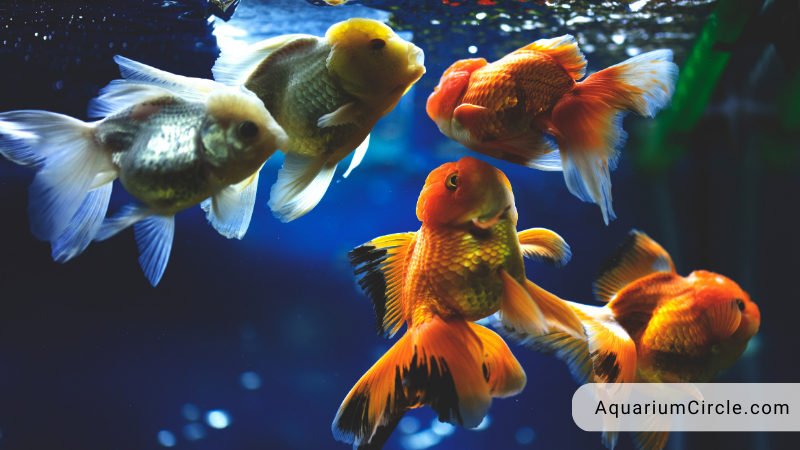
Oranda Goldfish can grow quite large, and as a result, they require a relatively large tank to accommodate their size and swimming habits. The minimum recommended tank size for a single Oranda Goldfish is 20 gallons (75 liters), although a larger tank is preferable.
If you plan to keep multiple Oranda Goldfish, it is important to provide ample space to prevent overcrowding and territorial behavior. A good rule of thumb is to provide 10 gallons (38 liters) of water per fish, with a minimum tank size of 55 gallons (208 liters) for two fish.
It is also important to consider the shape and depth of the tank. Oranda Goldfish are active swimmers and require ample space to move around. A rectangular tank is preferable, as it provides more swimming room than a tall or round tank.
See also: 40 Gallon Goldfish Tank – Some Important Notes You Should Know
In addition to the tank size, it is important to provide appropriate filtration and regular water changes to maintain a healthy environment for your Oranda Goldfish. By providing ample space and proper care, you can help ensure that your Oranda Goldfish thrive and remain healthy in their tank.
Suitable Tank Mates For These Big Head Buddies
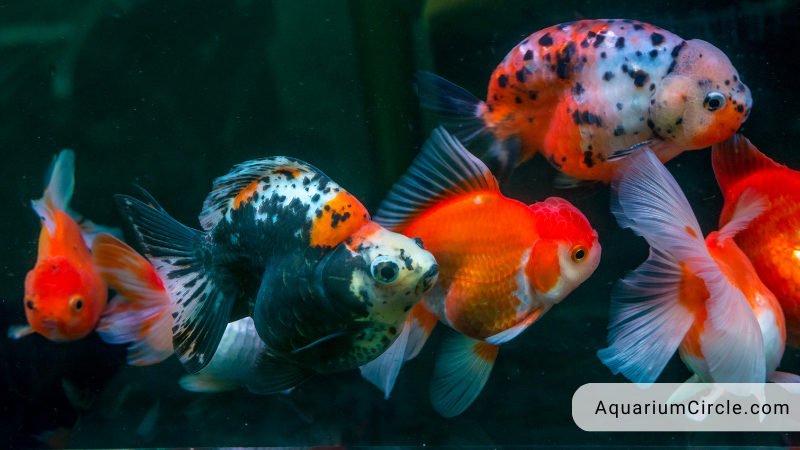
When selecting tank mates for Oranda Goldfish, it is important to choose species that are compatible with their peaceful temperament and cold-water requirements. Here are some suitable tank mates for Oranda Goldfish:
- Other types of Goldfish: Oranda Goldfish are social creatures and can coexist with other Goldfish species, such as Common Goldfish, Fantails, Ryukins, and Black Moors.
- White Cloud Mountain Minnows: These small, peaceful fish are cold-water compatible and make good tank mates for Oranda Goldfish.
- Dojo Loaches: These bottom-dwelling fish are cold-water compatible and can help keep the tank clean by eating leftover food and debris.
- Rosy Red Minnows: These small, peaceful fish are cold-water compatible and make good tank mates for Oranda Goldfish.
- Zebra Danios: These active, cold-water fish can coexist with Oranda Goldfish and add a pop of color to the tank.
- Snails: Cold-water species of snails, such as Nerite Snails or Mystery Snails, can help keep the tank clean and make interesting tank mates for Oranda Goldfish.
It is important to avoid species that may be too aggressive or territorial for Oranda Goldfish, such as Cichlids or aggressive catfish species. Additionally, it is important to avoid adding fish that may be too small or slow-moving, as they may become easy targets for the larger, more active Oranda Goldfish. By choosing compatible tank mates, you can create a harmonious and healthy environment for your Oranda Goldfish.
See also: Can Betta Fish Live With Goldfish? – 3 Reasons Why They Are Not Along
There are many other suitable tank mates for Oranda Goldfish, depending on your specific setup and preferences. Here are some additional options:
- Bristlenose Plecos: These cold-water compatible catfish are peaceful and can help keep the tank clean by eating algae and debris.
- Kuhli Loaches: These slender, peaceful fish are cold-water compatible and can add interest to the bottom of the tank.
- Guppies: These small, colorful fish are cold-water compatible and can add a pop of color to the tank.
- Harlequin Rasboras: These peaceful fish are cold-water compatible and can add a schooling element to the tank.
- Corydoras Catfish: These cold-water compatible catfish are peaceful and can add a bottom-dwelling element to the tank.
- Shrimp: Cold-water species of shrimp, such as Amano Shrimp or Cherry Shrimp, can help keep the tank clean and make interesting tank mates for Oranda Goldfish.
When selecting tank mates, it is also important to consider factors such as size, temperament, and water requirements to ensure compatibility with your Oranda Goldfish. Additionally, it is important to avoid overstocking the tank, as this can lead to poor water quality and health problems for your fish.
Diet And Feeding: What Food Shoud You Feed Your Oranda?
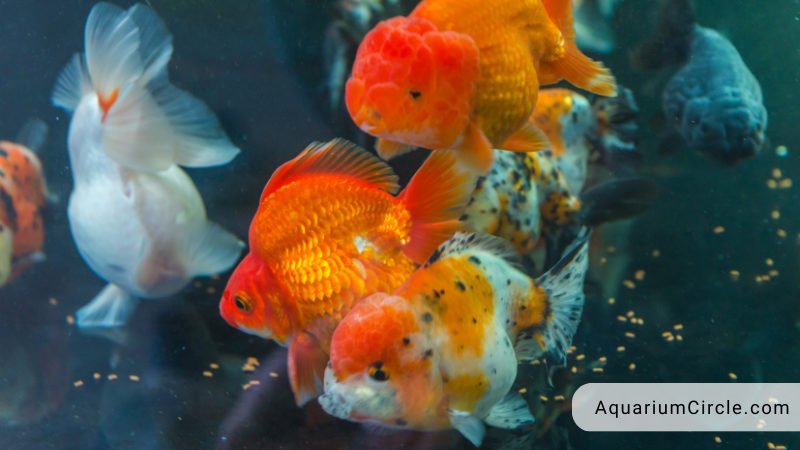
Oranda Goldfish are omnivores and require a balanced diet to stay healthy. A well-balanced diet for Oranda Goldfish should include a mix of protein, fiber, vitamins, and minerals. Here are some food options that you can feed your Oranda Goldfish:
- High-quality commercial fish food: A staple diet for Oranda Goldfish can be high-quality commercial fish food in the form of flakes or pellets. Choose a brand that is specifically formulated for Goldfish and contains a mix of plant-based and animal-based ingredients so that you can feed flake food every day, as well as pellets.
- Vegetables: Oranda Goldfish also enjoy snacking on vegetables like peas, spinach, lettuce, and zucchini. You can blanch or boil the vegetables before feeding them to make them easier to digest.
- Live food or frozen foods: Oranda Goldfish also enjoy live or frozen foods such as brine shrimp, bloodworms, and daphnia. These foods can be offered as treats to supplement their diet.
- Pelleted vegetable matter: Some brands offer pelleted vegetable matter specifically for Goldfish. These are made of algae and other plant-based ingredients and provide a good source of fiber and nutrients for Oranda Goldfish.
- Homemade food: You can also prepare homemade food for your Oranda Goldfish using ingredients like cooked peas, carrots, spinach, and fish meat. However, it is important to ensure that the food is nutritionally balanced and does not contain any harmful additives.
Feeding schedule for these goldfish with big head
Oranda Goldfish should be fed small amounts of food several times a day. A general feeding schedule for Oranda Goldfish can include the following:
- Feed small amounts of food two to three times a day: Offer a small amount of food that can be consumed in two to three minutes. Overfeeding can lead to health problems and poor water quality.
- Remove any uneaten food: If any uneaten food is left in the tank after feeding, remove it to avoid water quality issues.
- Alternate between different types of food: Offer a varied diet that includes high-quality commercial fish food, vegetables, and live or frozen foods. This will ensure that your Oranda Goldfish receives all the necessary nutrients for good health.
- Consider fasting once a week: To help prevent digestive issues, consider fasting your Oranda Goldfish for one day a week. This will also give their digestive system a chance to rest.
It is important to adjust the feeding schedule based on the size and activity level of your Oranda Goldfish. If your Oranda Goldfish is still hungry after feeding, you can gradually increase the amount of food offered. On the other hand, if your Oranda Goldfish shows signs of bloating or digestive issues, you may need to reduce the amount of food offered. Additionally, always ensure that the water quality in the tank is optimal and that the filter is functioning properly.
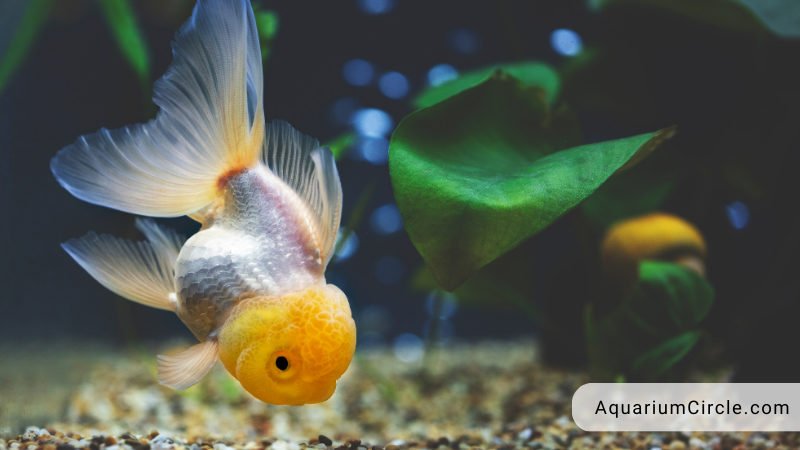
How to prevent overfeeding and obesity in Oranda Goldfish?
Overfeeding and obesity can be common problems for Oranda Goldfish. Here are some tips to prevent overfeeding and keep your Oranda Goldfish healthy:
- Feed small amounts: Offer a small amount of food that your Oranda Goldfish can consume in two to three minutes. If there is any uneaten food, remove it from the tank.
- Stick to a feeding schedule: Establish a feeding schedule for your Oranda Goldfish, and stick to it. Avoid feeding them more than three times a day, as this can lead to overfeeding.
- Monitor their weight: Keep track of your Oranda Goldfish’s weight and body condition. If you notice that they are becoming overweight, adjust their feeding schedule or the amount of food offered.
- Avoid overfeeding with treats: While it’s okay to offer your Oranda Goldfish treats, such as live or frozen foods, make sure they are not the only source of food. Treats should be given in moderation and only once a week.
- Consider fasting once a week: To prevent digestive issues and obesity, consider fasting your Oranda Goldfish for one day a week.
- Choose a balanced diet: Offer a balanced diet that includes high-quality commercial fish food, vegetables, and live or frozen foods. Avoid feeding your Oranda Goldfish foods that are high in fat or sugar.
- Provide enough swimming space: Make sure that your Oranda Goldfish has enough swimming space in the tank. This will help them exercise and burn off excess calories.
By following these tips, you can help prevent overfeeding and obesity in your Oranda Goldfish, and ensure they stay healthy and happy.
See also: Can Overfeeding Goldfish Kill Them? 5 Tips To Avoid Overfeeding
Common Health Issues That Affect Oranda Goldfish
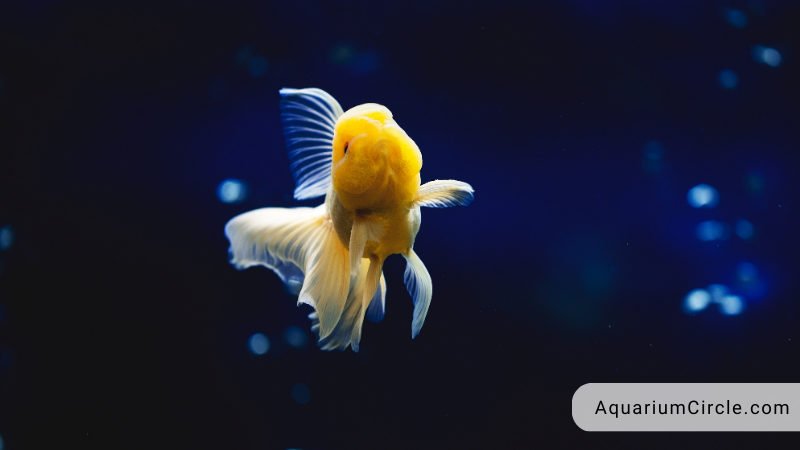
Like all fish, Oranda Goldfish are prone to certain health issues. Here are some common health issues that can affect Oranda Goldfish and how to treat them:
- Swim bladder disorder: This is a common condition that affects the swim bladder, which controls buoyancy in fish. Symptoms include swimming upside down, floating to the surface, or sinking to the bottom. Treatment options include fasting the fish for a few days or feeding them a diet of boiled peas to help regulate their digestion.
- Fin rot: This is a bacterial infection that affects the fins of fish. Symptoms include torn or ragged fins, as well as reddening and inflammation of the fins. Treatment options include water changes, antibacterial medication, and improving water quality in the tank.
- Ich: Also known as white spot disease, ich is a parasitic infection that causes white spots to appear on the fish’s body. Symptoms also include flashing and scratching against objects in the tank. Treatment options include increasing the temperature of the water, adding aquarium salt, and medicating with a suitable ich medication.
- Dropsy: This is a bacterial infection that affects the fish’s internal organs, causing them to swell and appear bloated. Symptoms also include raised scales and lethargy. Treatment options include isolating the affected fish, improving water quality, and medicating with antibiotics.
- Velvet disease: This is a parasitic infection that causes a yellowish or brownish dust-like coating on the fish’s body. Symptoms also include lethargy and loss of appetite. Treatment options include medicating with a suitable velvet medication, increasing water temperature, and improving water quality.
It’s important to regularly monitor the health of your Oranda Goldfish and take immediate action if you notice any unusual behavior or symptoms. Additionally, providing optimal water conditions, a balanced diet, and adequate swimming space can help prevent many health issues in Oranda Goldfish. If you’re unsure about the health of your fish, it’s always best to consult with a veterinarian who specializes in fish health.
How to clean and maintain the tank to ensure the health of Oranda Goldfish?
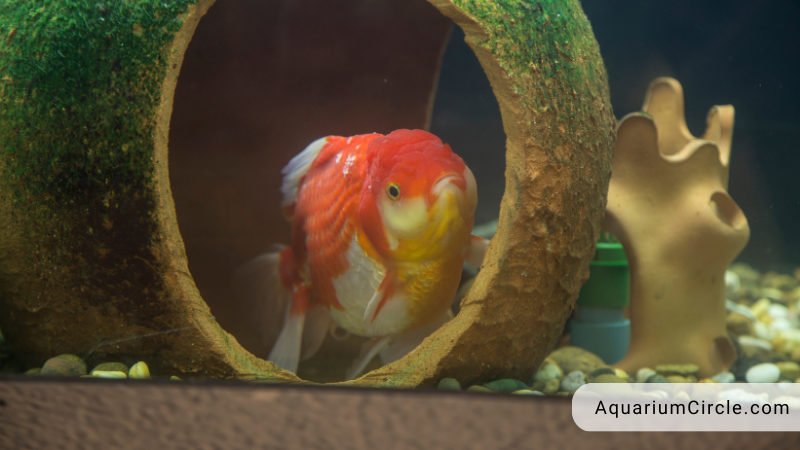
Maintaining a clean and healthy tank is essential for the well-being of your Oranda Goldfish. Here are some tips on how to clean and maintain the tank:
- Perform regular water changes: Regular water changes are essential for maintaining good water quality in the tank. Aim to change 20-25% of the water once a week, using a siphon to remove any debris from the bottom of the tank.
- Test the water regularly: Testing the water regularly using a test kit will help you monitor the pH, ammonia, nitrite, and nitrate levels in the tank. Aim to keep the pH level between 7.0-7.8, and ammonia and nitrite levels at zero.
- Clean the tank walls and decorations: Algae can accumulate on the walls of the tank and decorations, so it’s important to clean them regularly. Use an algae scraper or sponge to remove any buildup.
- Replace filter media regularly: The filter is essential for removing waste and maintaining good water quality in the tank. Replace the filter media, such as the carbon or sponge, every four to six weeks to ensure it is working effectively.
- Avoid overstocking the tank: Overstocking the tank can lead to poor water quality and stress on the fish. Follow the general rule of thumb of one inch of fish per gallon of water.
- Provide adequate aeration: Oranda Goldfish require a lot of oxygen, so it’s important to provide adequate aeration in the tank. Use a filter or air pump to oxygenate the water.
- Avoid using chemicals: Avoid using chemicals such as cleaning agents or medications in the tank, as they can harm the fish. Use natural methods, such as water changes and algae scrapers, to maintain a clean tank.
By following these tips, you can ensure a clean and healthy environment for your Oranda Goldfish, which will help prevent diseases and promote their overall well-being.
Breeding
Breeding Oranda Goldfish is a fascinating process that requires patience, dedication, and the right conditions. Here’s an overview of the breeding process for Oranda Goldfish:
- Select healthy adult fish: To breed Oranda Goldfish, you need to start with healthy adult fish. Look for fish that are at least 2-3 years old, have good body shape and color, and exhibit strong swimming behavior.
- Condition the fish: Before breeding, it’s essential to condition the fish by providing them with a varied diet and a suitable environment. Feed them high-quality foods such as live or frozen brine shrimp, bloodworms, and vegetables, and ensure that the water temperature is between 68-74°F.
- Set up the breeding tank: To breed Oranda Goldfish, you need to set up a separate breeding tank that is free of any other fish. The breeding tank should have a sponge filter and be well-aerated.
- Introduce the male and female fish: Once the fish are conditioned and the breeding tank is set up, introduce the male and female fish into the tank. Observe their behavior to ensure that they are compatible and that the male is actively courting the female.
- Spawning: Oranda Goldfish are egg layers and will spawn by swimming together in circles, with the male nudging the female to release her eggs. The male will then fertilize the eggs as they are released.
- Egg collection: Once the eggs are laid, remove the adult fish from the breeding tank to prevent them from eating the eggs. The eggs will hatch in about 3-5 days, and the fry will start swimming freely after another 3-5 days.
- Rearing the fry: Once the fry are swimming freely, feed them small amounts of high-quality foods such as baby brine shrimp, crushed flakes, and finely chopped vegetables. Monitor their growth and health closely, and perform regular water changes to ensure good water quality.
Breeding Oranda Goldfish can be a rewarding and exciting experience, but it requires careful planning and preparation. With the right conditions and care, you can successfully breed these beautiful fish and raise healthy fry.
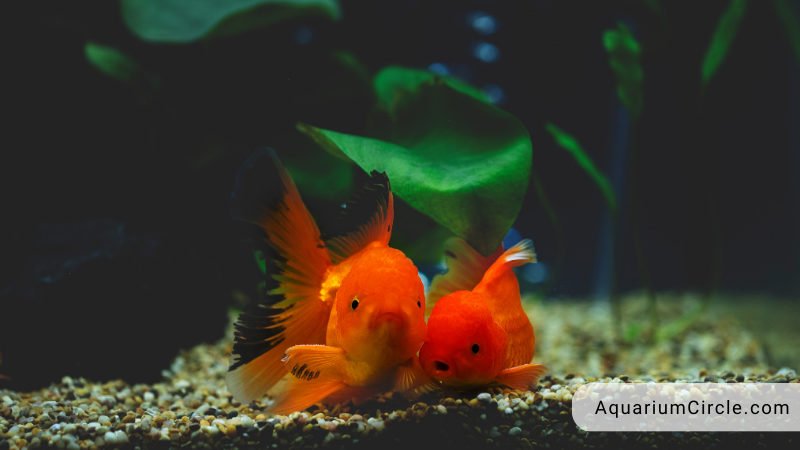
How to determine the sex of Oranda Goldfish?
Determining the sex of Oranda Goldfish can be challenging, especially in young fish. However, there are a few physical differences between male and female Orandas that can help you identify their sex:
- Body shape: Male Oranda Goldfish tend to have a slimmer and more streamlined body shape, while females tend to have a rounder and more robust body shape.
- Breeding stars: During the breeding season, male Oranda Goldfish may develop small white bumps, called breeding stars, on their pectoral fins and gill plates. These are used to attract females and indicate that the male is ready to breed.
- Papilla: In mature female Oranda Goldfish, a small protrusion, called a papilla, can be seen near the vent. This is the opening where eggs are released during spawning.
- Behavior: During breeding season, male Oranda Goldfish may exhibit more aggressive behavior, chasing and nudging females to induce spawning.
It’s important to note that these characteristics can vary between individual fish, and it may be challenging to determine the sex of young Oranda Goldfish. Additionally, some male fish may not develop breeding stars, and some females may not have a visible papilla. Overall, patience and careful observation are essential when trying to determine the sex of Oranda Goldfish.
Should You Pick Oranda Goldfish For Your Aquarium?
Whether or not you should consider Oranda Goldfish for your aquarium depends on several factors, including your level of experience as an aquarist, the size of your aquarium, and your ability to meet their specific needs.
Oranda Goldfish are a popular and attractive addition to many aquariums due to their distinctive body shape and color patterns. However, they do require a larger aquarium with excellent water quality, as well as a suitable diet and compatible tank mates.
If you are a beginner aquarist, you may want to start with more hardy and low-maintenance fish species before considering Oranda Goldfish. However, if you have experience caring for fish and are willing to invest the time and effort to provide them with optimal care, Oranda Goldfish can be a rewarding and fascinating addition to your aquarium.
It’s important to do your research and ensure that you are fully prepared to provide the necessary care and maintenance for Oranda Goldfish before introducing them to your aquarium. Consult with a reputable pet store or aquarium specialist, and be sure to monitor your fish closely for any signs of health problems. With proper care, Oranda Goldfish can live for many years and provide enjoyment and beauty to your aquarium.
Video About Oranda Goldfish – Goldfish With Big Head
FAQs
Are Oranda Goldfish friendly?
Oranda Goldfish are generally peaceful and social fish that can be friendly towards their owners and tankmates. They are known to recognize their owners and even interact with them during feeding times.
Are Oranda Goldfish easy to take care of?
Oranda Goldfish are generally considered to be easy to take care of, but they do have some specific care requirements that need to be met. They require a spacious aquarium with good filtration and aeration to maintain a healthy environment, and they prefer water that is slightly alkaline with a moderate hardness level. Oranda Goldfish are also omnivores and need a balanced diet consisting of high-quality pellets or flakes, as well as live or frozen foods.
What is the average size of an Oranda Goldfish?
The average size of an Oranda Goldfish is around 6 to 8 inches (15 to 20 cm) in length, although some can grow up to 12 inches (30 cm) in length.
References

Annette M. Chaney is an experienced marine biologist with over 20 years of experience as an aquarist and fishkeeper. She started her first aquarium at a young age, filling it with frogs and goldfish obtained from the ten-cent pet store.
Annette grew up caring for and breeding African Cichlids, which led to a hobby in high school that doubled as a profitable means. Attending Reed College gave her time to solidify herself as an accomplished aquarium caretaker with an eye for sales. After that, from 2009 – 2013, she studied at Roger Williams University – one of the most prestigious universities for Aquaculture and Aquarium in USA. She is the founder of AquariumCircle since 2010.
